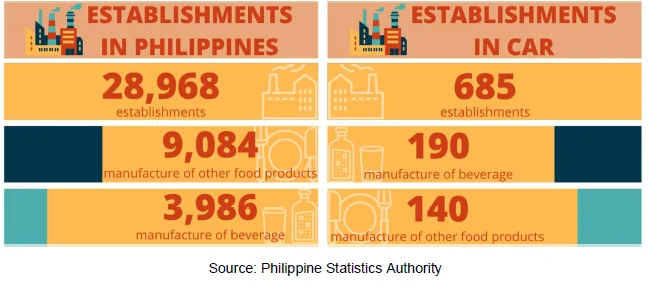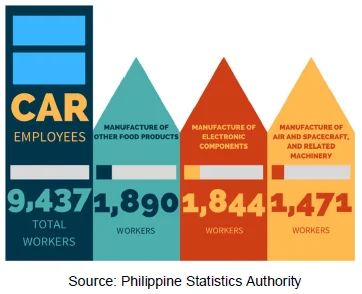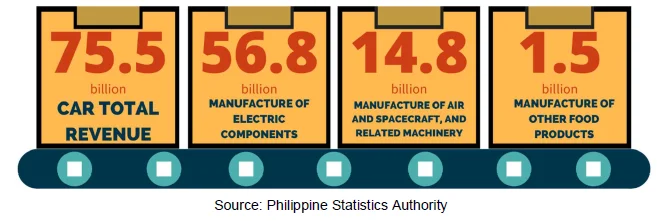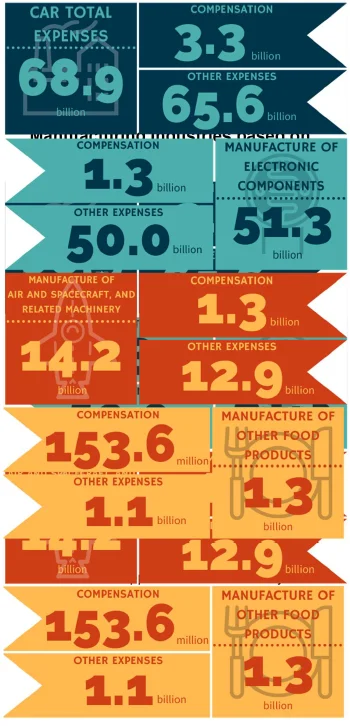Release Date :
Reference Number :
SR 2021-24
The Census of Philippine Business and Industry (CPBI) is one of the national censuses conducted by the Philippine Statistical Authority (PSA), undertaken every five years, which aims to collect and generate information on the levels, structure, performance, and trends of the formal sector of the economy. The results of the CPBI serve as credible basis for informed economic policies and development strategies as well as benchmark information in the measurement of national anf regional economic growth. The 2018 CPBI is the 16th of a series of economic censuses in the country.
This Special Release discusses the performance of the Manufacturing (MFG) sector, which includes 68 industry groups, in terms of number of establishments engaged in MFG activities, employment generated (as of 15 November 2018), total income and expense, value added, subsidies granted by the government, and sales from ecommerce transactions.
Manufacturing sector in Philippines grows by 15.6% in 2018
- The 2018 Census of Philippine Business and Industry (CPBI) showed that a total of 28,968 establishments were engaged in manufacturing in the country. This signified a 15.6 percent increase from the previous record of 25,064 establishments last 2012.
-
Thirty-one percent of the manufacturing establishments in the Philippines are from manufacture of other food products which includes manufacturing ofbakery products; sugar; cocoa, chocolate, and sugar confectionery; macaroni, noodles, couscous, and similar farinaceous products; prepared meals and dishes; food supplements from herbs and other plants; coffee roasting and processing; and manufacture of other food products which are not elsewhere classified. Manufacture of beverages inclusive of manufacture and blending of alcoholic beverage such as whisky, brandy, gin, distilled spirits, and neutral spirits; wines, fermented but not distilled alcoholic beverage; malt liquors such as beer, ale, etc. including the manufacture of low alcohol or non-alcohol; and manufacture of soft drinks, mineral waters, and other bottled waters follow with 13.8 percent of establishments.
-
Majority of Manufacturing establishments in the Philippines were concentrated in NCR which accounted for 16 percent of the total number of establishments. This was followed by CALABARZON and Central Luzon which had 13.9 and 11.7 percent shares, respectively. On the other hand, Cordillera Administrative Region accounted for 2.4 percent of the total manufacturing establishments in the country.
Figure 1. Total Number of Establishments and Top Manufacturing Industries in
Terms of Establishments, Philippines and CAR: 2018

CAR Manufacturing sector grows by 300-fold in 2018
- The Manufacturing sector of the Cordillera Administrative Region was composed of 685 establishments in 2018. This was 300.6 percent more than the recorded 171 establishments in 2012.
-
For Cordillera Administrative Region, 27.7 percent of manufacturing establishments are from manufacture of beverages followed by manufacture ofother food products with 20.4 percent.
Manufacture of Other Food Products employs the most people among MFG sub-industries
- The manufacturing sector in the Philippines employed a total number of 1,260,512 workers in 2018 which showed a 6.3 percent increase from the 1,185,998 workers in 2012.
-
Manufacturing of other food items, which ranked first in terms of the number of enterprises in the manufacturing sector, also ranked first in terms of employment. This was followed by manufacture of electronic components which employed for 142,340 workers or 11.3 percent of the total, and manufacture of wearing apparel (except fur apparel) with 98,868 workers or 7.8 percent of the total.
-
CALABARZON employed most with 496,158 workers or 39.4 percent of the total employment of the country. This was followed by NCR and Central Luzon with 253,067 and 157,665 employees, respectively.
Employment in manufacturing establishments in CAR grows in 2018
- In the Cordillera Administrative Region, the manufacturing sector employed 9,437 workers in 2018. This showed a 13.5 percent growth from the 8,314 workers last 2012.
-
Manufacturing of other food products hired the most employees at 1,890 workers. This was closely followed by the recorded employment in the manufacture of electronic components (1,844 workers) and manufacture of air and spacecraft, and related machinery (1,471 workers).
Figure 2. Total Number of Employees
and the Top Manufacturing Industries based on Employment, CAR: 2018

Manufacturing revenues rise by 26%
- The manufacturing sector in the Philippines acquired a total of PhP 5.8 trillion in 2018, exhibiting a 26.5 percent increase from the total revenue of PhP 4.6 trillion in 2012.
-
Accumulating a total of PhP 639.4 billion, manufacture of electronic components was the top industry in terms of revenue. It was followed by manufacture of beverages, with PhP 405.5 billion total earnings, and manufacture of other food products, with PhP 365.4 billion.
-
Most of the revenue of the manufacturing sector was contributed by CALABARZON, accounting for almost half of the total income of the industry. NCR and Central Luzon followed with PhP 1.2 trillion (20.9 percent) and PhP 940.5 billion (16.3 percent), respectively.
CAR contributes 1.3% to national income of Manufacturing
- Cordillera Administrative Region accumulated a total revenue of PhP 75.5 billion, or 1.3 percent of the total revenue of the Manufacturing industry in 2018. Manufacture of electric components gained the most with PhP 56.8 billion. It is followed by manufacture of air and spacecraft, and related machinery with PhP 14.8 billion (19.6 percent) accumulated revenue; and manufacture of other food products with PhP 1.5 billion.
Figure 3. Total Revenue and the Top Manufacturing Industries Based on
Revenue, CAR: 2018

Manufacturing sector spends 34.8% more in 2018
- Expenses of manufacturing sector reached PhP 5.3 trillion in 2018. Compared to the PhP 3.9 trillion expenditure of the sector in 2012, total expenses in 2018 increased by 34.8 percent.
- The top-earner manufacture of electric components turned out to be the top spender of the industry with an accumulated expense of PhP 580.3 billion in 2018. It was followed by manufacture of beverage which spent PhP 344.0 billion, and manufacture of refined petroleum products with PhP 318.7 billion
- Region-wise, CALABARZON spent a total of PhP 2.3 trillion in 2018; majority of the total expenses of the industry. This was followed by NCR and Central Luzon with PhP 1.1 trillion and PhP 825.7 billion worth of expenditures.
Compensation expenses up by 47.6%
- Almost 8 percent of the total manufacturing industry expenses were used to compensate its employees. This showed a 47.6 percent growth compared to 2012.
- Manufacture of electronic components turned out to be the top industry in terms of compensating paid workers, spending PhP 58.5 billion. Manufacture of other food products and manufacture of dairy products followed with PhP 38.3 billion and PhP 22.8 billion, respectively. There sub-industries comprise 29 percent of manufacturing industry’s total compensation expenses.
Total Expenses of Manufacturing Sector in CAR declines in 2018
- The manufacturing sector in the Cordillera Administrative Region accumulated PhP 65.5 worth of expenses in 2018. This showed a 53.3 percent decline from the PhP 147.3 billion in 2012.
- The manufacturing sector in the Cordillera Administrative Region accumulated PhP 65.5 worth of expenses in 2018. This showed a 53.3 percent decline from the PhP 147.3 billion in 2012.
-
Manufacture of electronic components was the major spender in CAR for 2018, accounting for 74.5 percent of the total industry expenditures. This was followed by manufacture of air and spacecraft, and related machinery (PhP 14.2 billion) and manufacture of other food products (PhP 1.3 billion).
-
Five percent of the total expenses of CAR was spent to compensate its employees. This was a 17.9 percent growth from the PhP 2.8 billion spent in 2012.
-
Manufacture of electronic components and manufacture of air and spacecraft, and other related machinery spent the most in terms of employee compensation, accumulating to PhP 2.6 billion. Manufacture of other food products followed with PhP 153.6 million worth of compensation.
Figure 4. Total Expenses and the Top
Manufacturing Industries Based on Expenses, CAR: 2018

Manufacturing sector earns PhP 12.3 billion from e-commerce
- The manufacturing sector acquired a total of PhP 12.3 billion from sales from e-commerce transactions. More than half of the earnings was generated from NCR with PhP 8.6 billion and was followed by Central Luzon and CALABARZON, with PhP 2.2 billion and PhP 752.5 million, respectively.
- Manufacture of basic precious and other non-ferrous metals earned majority of the total income from e-commerce with PhP 7.8 billion. Manufacture of paper and paper products came after with PhP 624.5 million earnings, and manufacture of glass and glass products with PhP 500.6 million.
- Cordillera Administrative Region accumulated a total of PhP 11.2 million from e-commerce transactions. This was generated from manufacture of furniture, with PhP 8.8 million; and manufacture of other food products, with PhP 2.4 million.
Figure 5. Total Sales from E-commerce Transactions and Top Industries Based
on E-commerce Sales, CAR: 2018

